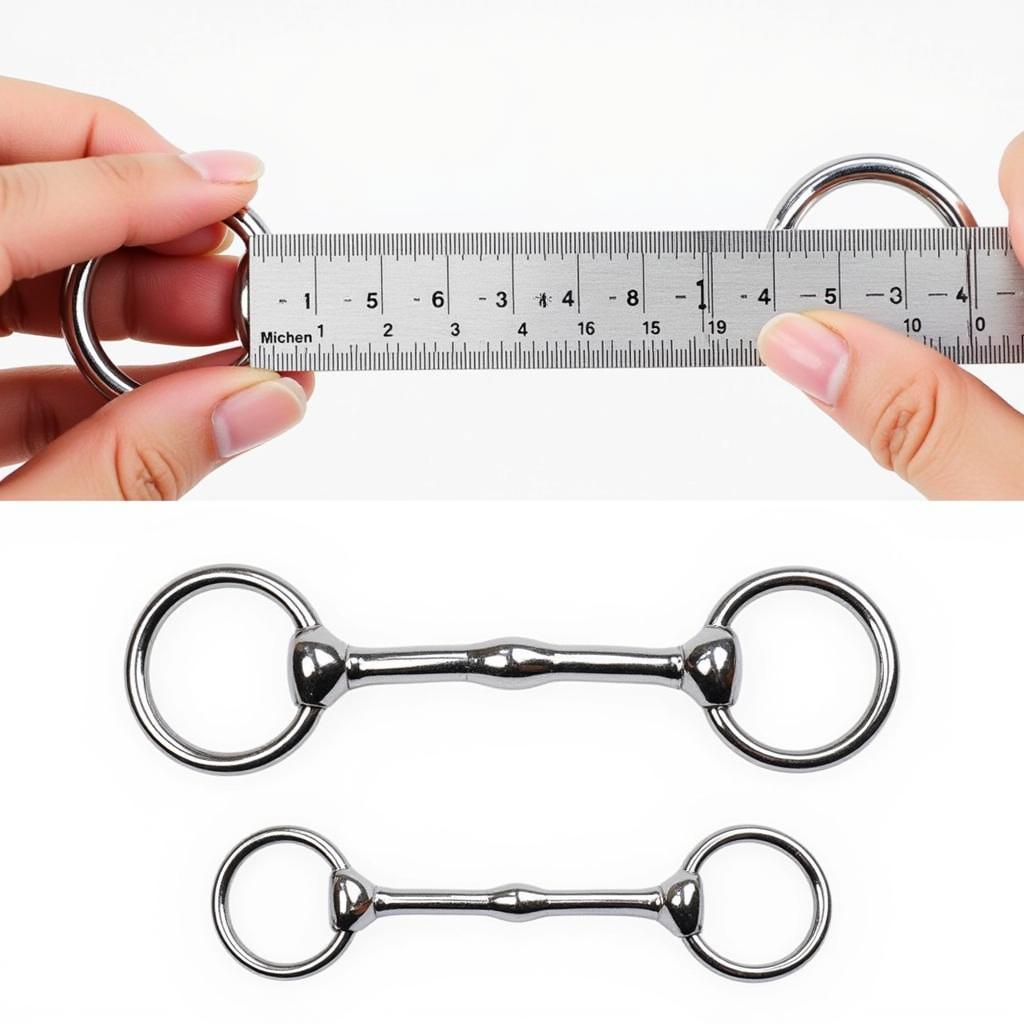Accurately measuring horse bits is crucial for your horse’s comfort and performance. An ill-fitting bit can cause pain, resistance, and even injury. This comprehensive guide will teach you How To Measure Horse Bits effectively, ensuring a perfect fit for your equine companion.
Understanding the Importance of Correct Bit Measurement
Choosing the right bit size is as important as choosing the right saddle. A bit that’s too small will pinch and rub, while a bit that’s too large can slide around in the horse’s mouth, causing confusion and discomfort. Properly measuring horse bits prevents these issues and promotes clear communication between horse and rider.
Different Types of Bits and Their Measurements
There are numerous types of horse bits, each with its own specific measuring considerations. Snaffle bits, curb bits, and pelhams all have different designs and actions, and their measurements will vary accordingly. While the general principle of measuring bit width remains the same, understanding the nuances of each type is crucial. For instance, a loose ring snaffle might need a slightly wider measurement to accommodate the movement of the rings.
Measuring Snaffle Bits
Snaffle bits are the most common type of bit, and measuring them is relatively straightforward. You’ll need a ruler or a flexible tape measure. Place the bit on a flat surface and measure the distance between the inside edges of the rings. This measurement represents the bit width and is usually expressed in inches. A correctly fitted snaffle bit should extend approximately ¼ inch beyond the corners of the horse’s mouth on each side.
 Measuring the width of a snaffle bit
Measuring the width of a snaffle bit
Measuring Curb Bits
Curb bits are more complex and require additional measurements. Besides the bit width, you also need to consider the length of the shanks and the purchase of the bit. The shank length influences the leverage and severity of the bit, so accurate measurement is essential. The purchase refers to the distance between the mouthpiece and the top of the shanks, and it affects how the bit acts on the horse’s poll and chin groove.
Tools for Measuring Horse Bits
Having the right tools makes measuring horse bits a breeze. A flexible tape measure is ideal for getting accurate measurements, especially for curved mouthpieces. A ruler can also be used, but ensure it’s placed correctly against the inside edges of the rings. You might also consider using a bit gauge, a specialized tool designed specifically for measuring horse bits.
Tips for Accurate Measurement
- Ensure the bit is clean and free of debris before measuring.
- Use a flexible tape measure for curved mouthpieces.
- Measure twice to ensure accuracy.
- Consult with a qualified equine professional if you’re unsure about the correct size.
Dr. Emily Carter, an equine veterinarian with over 20 years of experience, emphasizes the importance of proper bit fit: “A well-fitting bit is essential for the horse’s comfort and well-being. An improperly fitted bit can cause significant pain and lead to behavioral problems.”
Remember, a comfortable horse is a happy horse! Taking the time to measure your horse’s bit correctly will ensure a positive riding experience for both you and your equine partner.
Conclusion
Knowing how to measure horse bits correctly is a fundamental skill for any horse owner. A properly fitted bit ensures your horse’s comfort and allows for clear communication between you and your equine partner. By following these guidelines, you can choose the perfect bit size for your horse, enhancing both performance and well-being. When looking for children’s horse saddles, consider checking out our selection. Do you remember the story of a horse named Sky? It highlights the special bond between humans and horses.
FAQ
- How often should I check my horse’s bit fit? Regularly check your horse’s bit fit, especially if you notice any changes in their behavior or if they show signs of discomfort.
- What should I do if my horse’s bit is too small? Immediately replace a bit that is too small with a correctly sized one.
- Can I use a ruler to measure all types of bits? A flexible tape measure is recommended for curved mouthpieces, while a ruler can be used for straight bars.
- What if my horse has an unusually shaped mouth? Consult with a bitting specialist or an experienced equine dentist for advice on fitting bits for horses with unique mouth conformations.
- Where can I buy a bit gauge? Bit gauges can be purchased at most tack shops or online retailers.
- Is it okay to use a used bit? Used bits can be acceptable, but ensure they are clean, undamaged, and correctly sized for your horse.
- What are the signs of an ill-fitting bit? Signs of an ill-fitting bit can include head tossing, gaping mouth, resistance, and excessive salivation.
Do you have a wound on your horse that needs attention? Our wound spray for horses can help! If you are looking for a comprehensive resource on horse anatomy, our atlas of horse might be useful. We also offer a selection of horse riding helmets for kids.
Need more help on horse bit fitting or other equine-related topics? Contact us! Phone: 0772127271, Email: [email protected] or visit us at QGM2+WX2, Vị Trung, Vị Thuỷ, Hậu Giang, Việt Nam. We have a 24/7 customer service team.